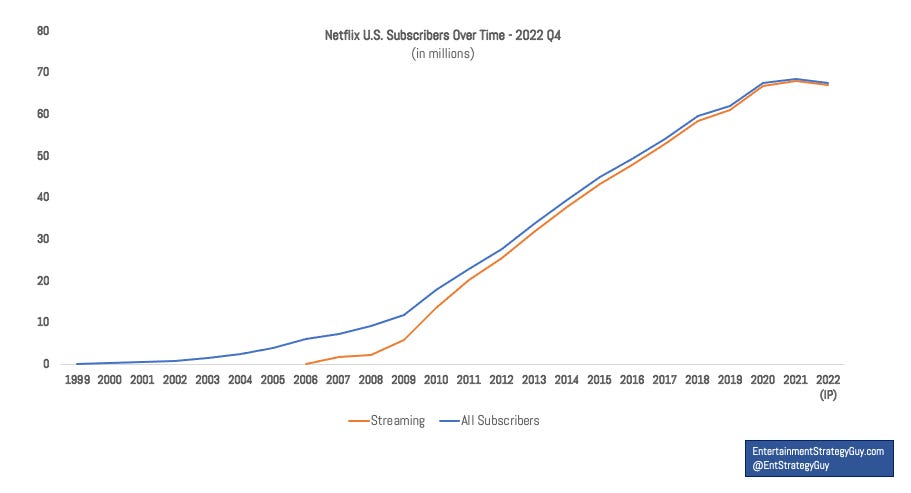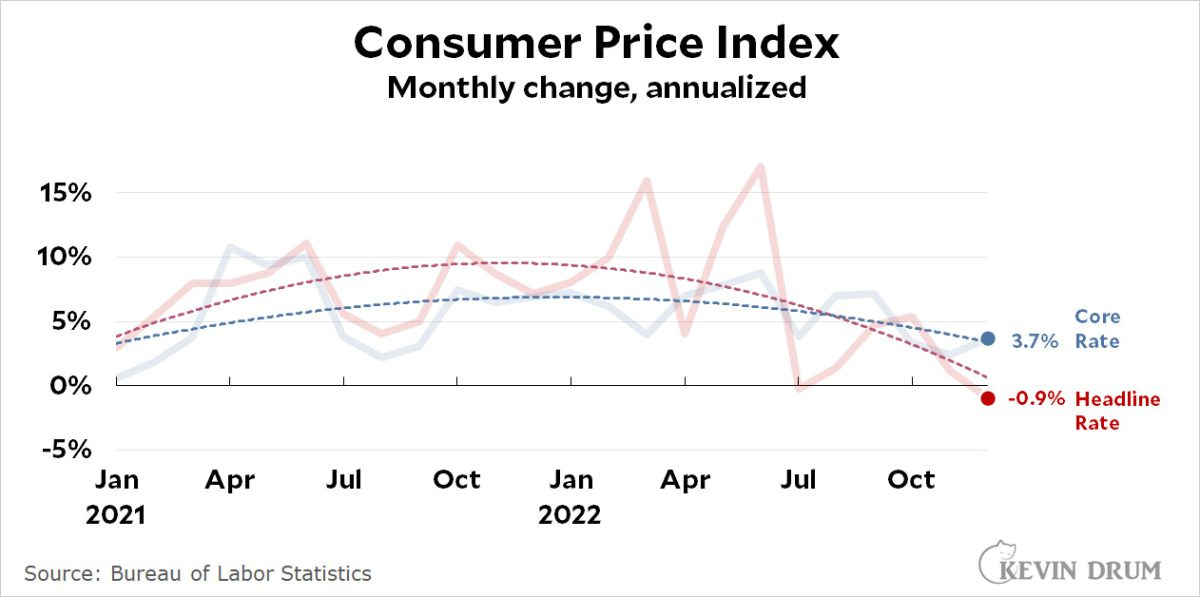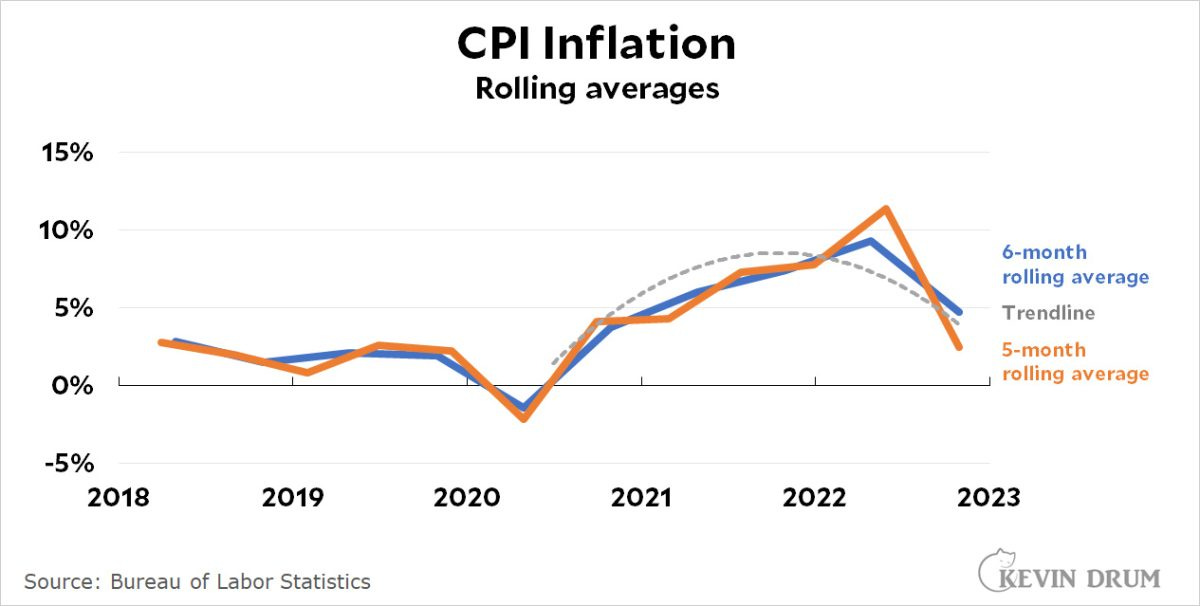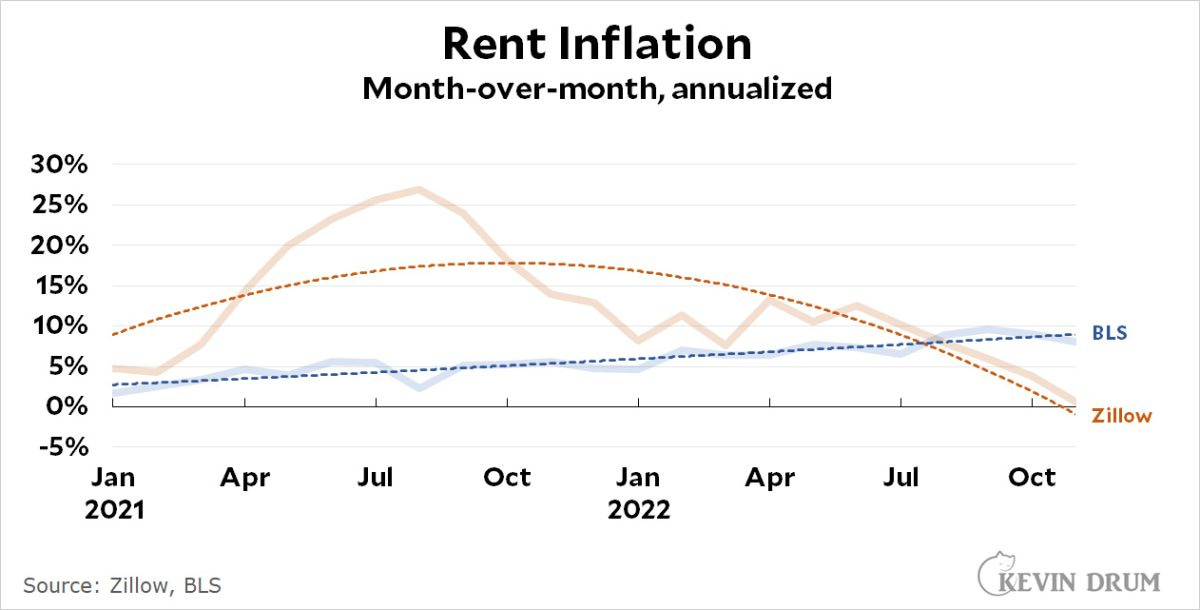What I Got Right, What I Got Wrong - Q4 2022 Edition
Predicting the future is hard. Four years ago, I didn’t think LeBron would ever pass Kareem Abdul-Jabbar as the NBA’s all time scoring leader, because I never thought he’d keep scoring at this elite rate or not suffer a major injury late in his career, à la Kobe Bryant or Dirk Nowitzki.
Now he’s set to break that record and, depending on how he plays, I’ve got tickets to that Lakers game! (But it depends on a number of variables when this happens. Predicting when something happens is really, really hard.)
As part of my extensive end-of-the-year tasks—including my "Question of the Year” article two weeks ago and my articles ranking the streamers here and for the Ankler earlier this month—I also want to revisit my ongoing series, “What I Got Right, What I Got Wrong.” (Earlier editions here and here.)
I wish more pundits, analysts and experts went through this exercise, regularly seeing if their past predictions were right or wrong. (And for this reason, more pundits should make predictions!) Yes, I celebrate what I got right, but I’m more interested in what I got wrong and, more importantly, why did I get it wrong? What did I miss? What facts or data should I have looked at instead?
Overall, this tends to make me more cautious and nuanced in my takes. (And I do a lot of hedging. But as I think I’ve written before, reality is hedged.) Again, predicting the future is hard!
Enough chit chat, let’s get right into it!
(We can only keep doing this great work with your support. If you’d like to read more about why you should subscribe, please read these posts.)
WRONG - Theatrical Box Office Will Rebound in 2022
Back in May, I wrote about the future of theaters and the projections that the US box office would struggle to make over $8 billion. At the time, I was skeptical.
“Partly, though, I just feel like ever The Number’s projections [predicting $7.5 billion in U.S. box office] are still too bearish. I mean, last year, with tons of theatrical titles delayed into 2022 and few blockbusters in the first half of the year, the box office was still $4.5 billion. With tons more blockbusters are we really only going to see numbers just $1.5 billion higher? That feels too low. This isn’t saying The Number’s forecast is low, just maybe conservative. This year is loaded with blockbusters, and to not turn in a nearly normal performance would cause major worries.”
Well, it’s safe to say, I was wrong, since the US box office wound up at $7.5 billion, 34% below 2019’s numbers. The-Numbers prediction was spot-on.
So what did I get wrong? Well, the two things I thought needed to happen to save theaters didn’t happen (yet, hopefully they do happen in the future):
Many older viewers didn’t return to theaters, especially this fall, as many people have written about recently.
Mid-tier films didn’t perform well...because there’s just not a lot of those films.
As others have pointed out, and as I linked to recently, the number of films in theaters also fell by...35%. Since The-Numbers takes this into account in their model, no wonder they got the call spot on. Further, some blockbusters didn’t come out this year, as the studios moved a few titles back to 2023, including Into The Spider-Verse 2 and Mission Impossible 7.
I’ll mention one more factor for why I got this wrong: personal bias. Being blunt, I love going to the movies. I love taking my kids to the movies; I’ll see just about any kids film; it’s an excellent weekend activity. I want theaters to survive. And I think that biased my take on the future of theaters.1
Which actually relates to my biggest call of my career...
RIGHT - Netflix’s U.S. Subscribers Will Top Out at Around 70 million
I took a victory lap in January and April when Wall St. turned on streaming and Netflix’s sky-high valuation. But after Netflix’s most recent earnings report, my researcher prodded me to re-share why I got this right: I called it on Netflix’s U.S. subscriber count flattening out.
Here’s what I predicted back in 2019:
“When you apply the Bass Diffusion Model to Netflix’s US operations, the model which fits best has a market size in the United States of around 70-72 million subscribers. In other words, a saturated US market is much closer to the low end of Netflix’s projected outcome (60 million) than the high end (90 million)”
Now compare my estimate to Netflix’s sub counts, now:
I think the media, especially the entertainment press, got this wrong for the same reason I got my prediction about theaters wrong: they love streaming. (And a very specific version of streaming: ad-free, non-linear, all binge-released.) They wanted this future and this love of streaming translated into a near-utopian level of optimism for Netflix’s future, including insane predictions of Netflix’s future U.S. subscribers and the belief that Netflix would become “all television”.2
Okay, that was a good call for me, let’s go back to what I got wrong:
WRONG - Bob Chapek Won’t Get Fired as Disney CEO
Actually, going through my archives, I can’t find anywhere that I predicted anything about Bob Chapek’s future with Disney. All I wrote in June was...
“Between Bob Chapek’s renewal by the Disney board or Lightyear’s miss at the box office (a miss that only stings deeper as the Minion’s franchise set records), Disney was on everyone’s minds.”
Instead, I did a tweet thread after the Peter Rice firing:

Even though I didn’t write it, explicitly, I didn’t think that Chapek would get fired so soon after the Disney board re-upped his contract, so I’m counting this as a miss anyway. But I could have predicted why he would get fired: worries about the stock price and future finances of the company. In the end, I didn’t see this coming, but I stand by my original convictions: ScarJo, Florida and Peter Rice had little to do with this; Disney’s financials, though, did.
MISS - John Lasseter’s Departure Will Be Bad for Disney (I Should Have Called My Shot!)
Okay, apologies for the awkward subtitle, but I could have sworn that, when John Lasseter left Disney, I predicted that this would be bad for Disney Animation. I didn’t. Instead, I hedged pretty hard. When Bob Iger stepped down, the first time, I explained four of the biggest risks for Disney, including this point:
“First, Lasseter turns out to be have been crucial for animation. (Like Frank G Wells was in the 1980s.) Arguably, since Iger moved Lasseter to Disney Animation, that side of the business rebounded. (Why might this not be true? Read Kim Master’s take here.) We’ll find out in about 1 to 2 years if this is true.”
Four years later and...Disney just had its worst year in animation yet, with two huge flops, Strange World and Lightyear.
I should have been bolder at the time. Lasseter is one of the (very, very) rare creative talents in Hollywood that could consistently make hits and develop other people’s hits, up there with Shonda Rimes, Kevin Feige, Chuck Lorre, Dick Wolf and a handful of others. Pixar cranked out hits for decades. Disney Animation almost instantly turned around under his watch. Replacing him wasn’t going to be easy. And now that he’s gone, Disney Animation is floundering.
That said, this gets into thorny ethical territory: Lasseter may have been great, but giving him the boot may have still been the right call, for ethical reasons.
RIGHT - Latino Representation Is a Huge Market Opportunity
In my most popular series last year, “Who is the Average American Viewer?”, I pointed out:
“If Latino audiences are 24 percent of the country, why are they only 6 percent of the acting roles? Outside of the data on religious audiences, this was the single craziest statistic I came across.”
In September, a few weeks after this series came out, the Latino Donor Collaborative published another study, showing that Latino actors represent 3.1% of actors on TV, despite making up (at least) 20% of the US population. The numbers of writers and directors is similarly abysmal.
But can this demographic drive hits?
Well, look no further than the massive success of this year’s biggest breakout hit, Wednesday. Starring an all Latino cast, this show is Netflix’d biggest season one debut of all time. Yeah, this is one data point, but I don’t think this show’s success is an accident. This isn’t to say that all Latino-helmed or staring films and TV shows will be hits, but I’d bet we see a lot more hit films and TV shows starring Latino casts.
Finally, Axios also highlighted this survey, the "Global Faith and Media Index," from the Radiant Foundation and HarrisX, which found that many religious viewers don’t feel that the media is meeting their needs in terms of religious viewpoints, as I also wrote in the Average American series.
WRONG - The PE Bubble Will Pop
I keep predicting that the private equity bubble will pop soon and it keeps not popping. Check out this Hollywood Reporter headline:
And companies keep raising money:
“Religion of Sports, the sports media production company co-founded by Tom Brady, Michael Strahan and filmmaker and entrepreneur Gotham Chopra, has raised $50 million in a new series B funding round led by Shamrock Capital.”
“Ben Affleck and Matt Damon are reuniting as business partners with the launch Artists Equity, a production venture backed by RedBird Capital Partners that vows to expand profit participation and provide a “talent-friendly” environment to creatives. Media investor Gerry Cardinale’s RedBird is said to have committed at least $100 million to funding the venture.”
All that said, private equity may be a landmine waiting to blow up the entire economy. As The Economist has covered a few times, private markets are very loathe to downgrade their investments. Meaning you can have a situation where publicly traded stocks have been hammered, but private investments remain “flat”, as happened in 2022. When they are eventually forced to devalue their investments, the entire economy may feel the pain. Fun!
Lastly, the private equity party in music already seems to be over in some corners. For example, the music catalogue sales boom may have already busted, according to the excellent newsletter Penny Fractions.
(Though Justin Bieber sold his catalogue earlier this month.)
RIGHT - TikTok and Twitter are Overrated
Also in my “Who is the Average American Viewer?” series, I made the point that TikTok and Twitter are really over-rated, in terms of the media conversation; people think these platforms are way more popular than they are.3 I’m not saying that Twitter and its future isn’t important, but it’s far less important than most people think.
More importantly, I made a clear strategic point:
Twitter is NOT real life.
And it still isn’t. In November, Grid and Harris released a survey on social media use, under the provocatively but accurately titled headline, “Twitter and TikTok get all the attention. Polling shows few US adults use them”:
“Overall, YouTube, Instagram and Facebook are leading the pack, the survey shows. Three-quarters of U.S. adults have used Facebook in the last six months, with 71 percent using YouTube and 51 percent using Instagram. Just 34 percent reported using Twitter or TikTok...While TikTok has exploded in popularity, and reports of Facebook’s declining popularity (and profitability) abound, 44 percent of survey respondents who have used social media in the last six months said they used Facebook the most.
By contrast, just 8 percent said they used TikTok most often — and 4 percent said they used Twitter most often, according to the poll.”
In September, Pew Research released a study showing that 25% of Twitter users create 97% of the content. Again, if you think those 25% of Twitter users, which is already a fraction of overall Americans using social media, are representative of your audiences, you’re wrong.
RIGHT - Inflation is Still Going Down
It sure seems like inflation is going down, quite quickly. As always, we go to Kevin Drum:
In December, CPI was negative. (Point for “team transitory” or my take: no economist could have predicted the war in Ukraine raising gas prices ahead of time, since no one knew a war was coming even a mont ahead of time!)
Here's another look.
Even these numbers may be too pessimistic. After all, when it comes to housing prices, the Bureau of Labor Statistics doesn’t recalculate inflation monthly, but every six months. And all outside evidence shows rents going down right now.
A lot of last year’s inflation was caused by...companies using inflation as an excuse to raise prices, which Matt Stoller has been saying/predicting for a while now.
Meanwhile, it takes a year for interest rate raises to affect the economy. Luckily, in the fourth quarter, US GDP grew at 2.9%, over 2% for the year.
My biggest fear, like Drum’s, is still that the fed’s rate increases, which haven’t even affected the economy yet, were too aggressive and will cause a needless economic downturn later this year. But let’s keep our fingers crossed for a soft landing!
Quick Follow-Ups:
Okay, we’re running long, so some quick hits:
RIGHT - The Algorithm is a Lie. I’m probably going to write about this more next month, since I have so many new subscribers since when I first wrote one of my favorite articles, “The Algorithm is a Lie”. This Insider article on Netflix’s decision-making sure makes it sound like there’s no magic algorithm telling development execs what to make. Instead, Netflix has tons of data, then real life human beings argue over what it means.
RIGHT - Netflix is not an aggregator, says Stratechery! I’ve long been skeptical of the notion that Netflix is an aggregator and now Ben Thompson agrees with me! Again, Netflix is not becoming “all television”.
MISTAKE - Switching EBITDA and Net Debt. Over at The Ankler, in my first attempt at showing various company’s Net Debt to EBITDA ratios, I had the EBITDA and Net Debt flipped. Worse, I pulled the wrong year for Warner Bros Discovery, so their ratio was artificially high. This article has the right data. (Though I should update this chart!)
RIGHT - Adult Animation Still Struggling. In 2022, there’ve been even more cancellations of high profile adult animation shows, like Netflix cancelling Bad Crimes, despite the all star talent attached, including Nicole Byer, Lauren Lapkus, Greg Daniels and Mike Judge. That said, Peacock just ordered a new series from NPR, which THR dubbed the “red-hot adult animation genre.” As I wrote last year, this genre is not “red-hot” and didn’t save Hollywood following the pandemic. That said, as a contact in the industry told me, the budgets for these animated shows are a lot lower than live action, so I get the ROI logic here. It’s just a bit overrated as a genre right now, especially with very few notable hits outside of Rick & Morty over the last few years.
WRONG - Hollywood Mega-Deals Are at an End. In my latest Shonda vs. Ryan article at the Ankler, I speculated that we probably wouldn’t see a deal like it again. Of course, less than a month later Greg Berlanti just re-upped his deal with Warner Bros. Television—under the famously-cost conscious Zaslav—so I guess mega-deals aren’t gone? (I wrote about this last week as well.)
RIGHT - Hollywood’s Future is Grim. To close off on a less-than-cheery note, in my series on “Worst Case Scenarios” for each major entertainment company, I wrote up a list of industry wide risks. Well, as I wrote for the Ankler at the end of December, all of those trendlines got worse! As well, in that series, I worried about the production bubble bursting. And in the second half of 2022, orders for new series were down 24%, according to Ampere Analysis.
I also agree with James Cameron that going to a movie theater forces you to focus on the movie and really engage with it, without distraction, which is similar to my biggest piece of advice from last year.
Indeed, Netflix execs just reiterated this goal in that infamous Bela Bajaria profile in the New Yorker.
You’d be forgiven if you thought this after reading, after all the mountains and mountains of think pieces on Musk and Twitter.






